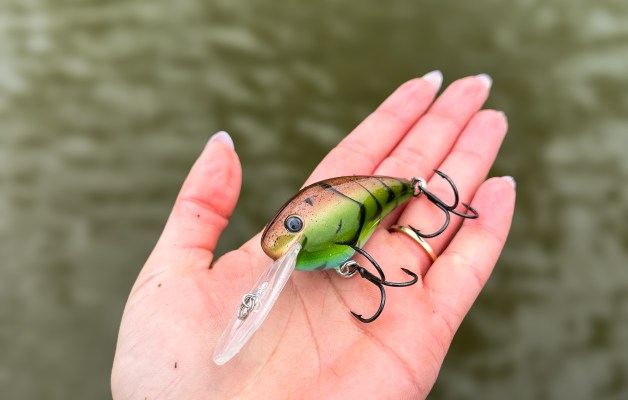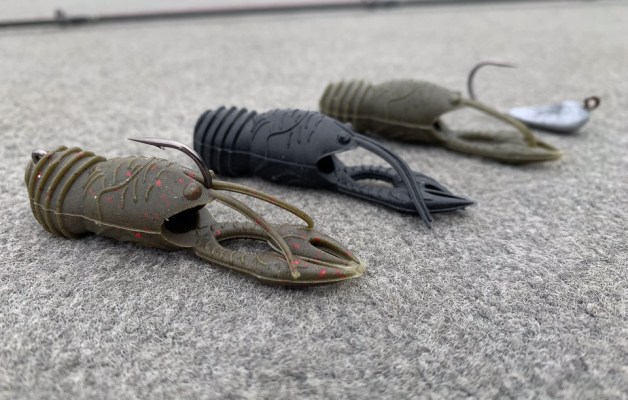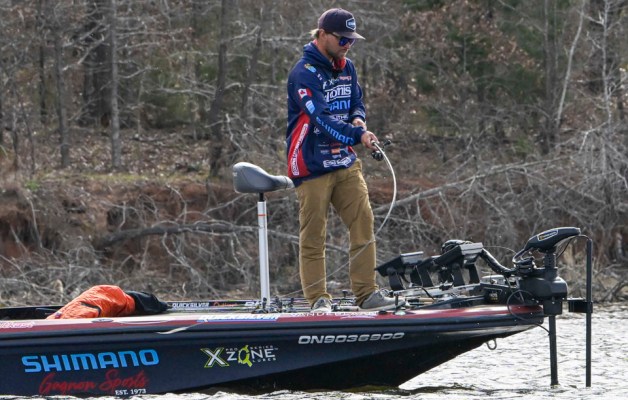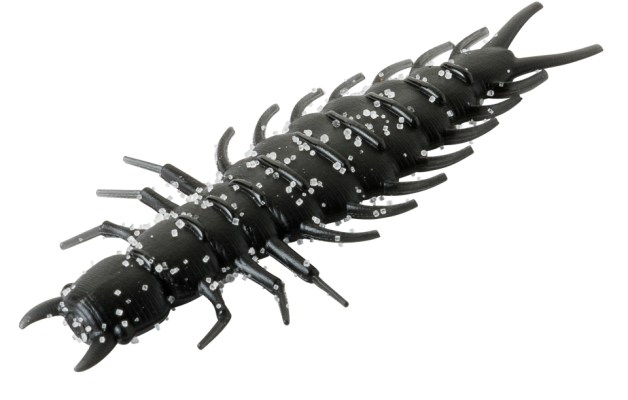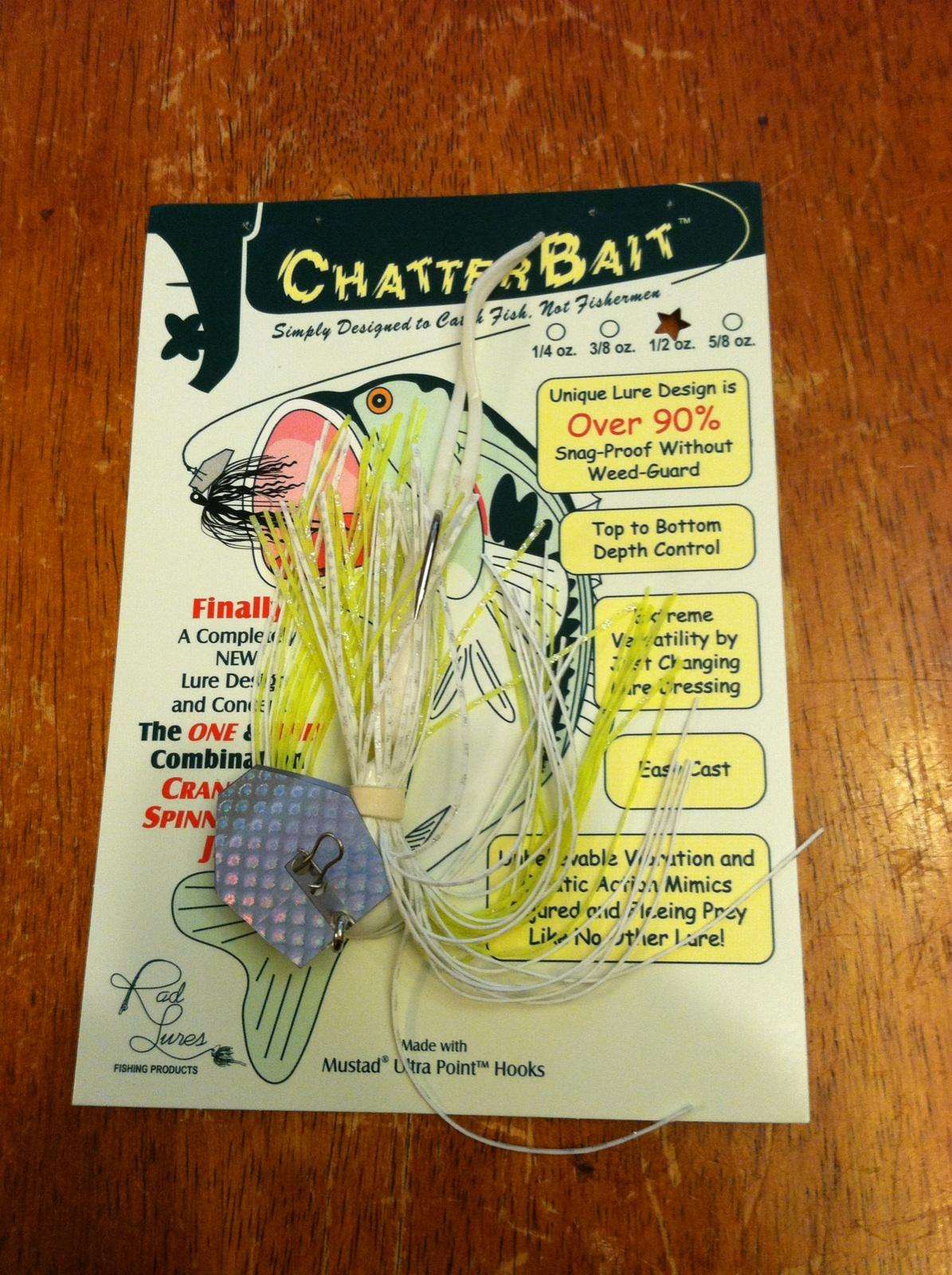
It was March 10, 2004, when the first ChatterBaits went on sale. Ronny Davis had been tinkering for years with the unusual-looking fishing lure featuring a hexagonal-shaped metal blade on a lead-head jig.
“The Sportsman’s Friend in Greenwood, S.C., took six dozen of them,” said Ron Davis, 40, the son in the father-and-son team that created the ChatterBait. “We thought that was a huge compliment, that they’d give us 12 pegs with six lures on each one.”
It’s now been 10 years since the humble beginnings of the ChatterBait.
“My father named it,” Ron said. “When we were working with prototypes in 2003, we couldn’t decide on a name. During a fishing trip to the Saluda River, he jokingly said the vibration was enough to make your teeth chatter. From that day forward, we referred to it as the ChatterBait.”
The Davis clan had made no special plans to mark the lure’s decade of existence. But reality has intervened. The past month has turned into one big celebration of the ChatterBait.
First, Brett Hite won an FLW Tour event at Lake Okeechobee on Feb. 9. Of the 20 bass he weighed over four days, nine were caught on a bladed jig, like the ChatterBait. Then the top three finishers in the GEICO Bassmaster Classic – Randy Howell, Paul Mueller and Edwin Evers – credited bladed jigs for key catches during the three-day event on Alabama’s Lake Guntersville that concluded Feb. 23.
“At the 10-year mark, it has pretty much established itself,” said Ronny Davis, 70, a now retired research and development lab technician. “I will always be proud of the ChatterBait.”
Added son Ron, “What happened at the Classic helped legitimize the bait. My dad and I still think of the ChatterBait as our baby.”
Raising that baby took a lot of work and a little luck. Annual sales during the early years of the ChatterBait illustrate what a rollercoaster ride this has been. In 2004, they sold 5,000 lures. In 2005, thanks to a marketing plan that featured a “hog trough” at five fishing shows, including the Bassmaster Classic, to demonstrate the unique vibrating action of the lure, sales jumped to 25,000. In 2006, the Davis clan borrowed money and mortgaged the future into a plan to produce 100,000 ChatterBaits. That strategy exploded quickly – in a good but problematic way. On Jan. 7, 2006, Brian Thrift of Shelby, N.C., won a Stren Series event at Lake Okeechobee using the ChatterBait.
“Four of the Top 10 guys in the next FLW tournament were using it and in less than two weeks we had orders for 500,000 baits,” Ron recalled.
At 10 cents apiece, the Davis family couldn’t even afford to buy the hooks for 500,000 ChatterBaits, much less obtain the other components and get the lures put together. Future Bassmaster Elite Series pro Casey Ashley of Donalds, S.C., was one of the many local people suddenly employed by RAD (Ronald Anthony Davis) Lures during the early months of 2006 to help meet the demand for ChatterBaits.
“Casey has built a lot of ChatterBaits,” Ron said.
After a few frenzied months, Z-Man Fishing Products offered some relief. The Charleston, S.C., company had previously been a large supplier of fishing lure components, like silicone skirt materials. Z-Man, operating in the wholesale world, was relatively unknown to most anglers. But the company had an infrastructure that could handle national demand. RAD Lures reached an agreement with Z-Man to build and distribute ChatterBaits in April 2006.
“It took them six months to catch up with the orders,” Ron said. “They took a huge burden off our backs. Over the next two years, we sold almost four million ChatterBaits.”
 Despite that success, the ChatterBait was on the verge of being labeled a gimmick, not to the degree of the Helicopter Lure, the Flying Lure or the Banjo Minnow, but not far from it. As one angler said, “It’s the best bait that everyone owns and nobody throws.”
Despite that success, the ChatterBait was on the verge of being labeled a gimmick, not to the degree of the Helicopter Lure, the Flying Lure or the Banjo Minnow, but not far from it. As one angler said, “It’s the best bait that everyone owns and nobody throws.”
That’s why this 10-year anniversary is so significant. It’s taken that long for a sufficient number of anglers to develop enough confidence in the lure to use it in place of the more traditional baits.
“A very small percentage of the people who bought the bait learned how to use it,” Ron said. “When something new comes out, everyone has got to get one. But unless you have a little success with it, you won’t use it much.”
It’s actually not so much about how to use a ChatterBait, it’s about why. When ChatterBaits first hit the market, they were described as a hybrid of a spinnerbait, a crankbait and a jig. They featured the lead head and skirt of a jig, the metal blade of a spinnerbait and the vibrating action of a crankbait. But if you’ve already got confidence in a particular spinnerbait or crankbait or jig, how long are you going to stick with a funny-looking hybrid? Tournament anglers are always looking for a competitive edge. Ultimately, they were the ones willing to spend some extra time with ChatterBaits and exploit its advantages.
It’s that vibration and how it’s produced that made the ChatterBait patentable and successful. The six-sided blade wasn’t anything new. Ronny Davis was aware of the Walker Special, a lure created by Walker Crawford in North Carolina decades earlier that featured a hexagonal blade. It’s the rapid oscillation of the blade, when coupled with a jighead, that makes the ChatterBait unique.
“How do you impart that action?” Ronny said. “I played with it for years and years and years. It would still be in my shop if not for my son.”
Bass fishing has always been the glue in their father-son relationship. They have long fished tournaments together, just like they did again last weekend.
“About 2003, he got the configuration right,” Ron said of his father. “But he wasn’t a believer in the product. I had to convince him. When we fished together, I made him fish with it, and that’s when he realized what we had.”
Ron had been convinced when fishing behind other anglers at heavily pressured local lakes.
“I could go right behind them and catch fish on it where they hadn’t caught anything,” he said.
Unlike a spinnerbait, a jig and a crankbait, the ChatterBait has a sound component that few anglers understand. Ronny Davis’s much-tinkered with design makes the hexagonal blade bounce off the lead head of the jig and reverse itself.
“It’s making all kinds of noise in the water,” Davis said.
It was Ronny’s background in research and development that led to the unique characteristics of the ChatterBait. He worked over 20 years for a company that made automobile tire cords. Before tires were reinforced with steel strands, various kinds of fibers, like polyester, were used in the search for a longer lasting tire.
“When I worked in research and development, I learned there was no such thing as a mistake,” Ronny said. “In everything you do, you learn from it.”
Davis’s R&D work with the ChatterBait centered on units of movement in the blade vs. units of pull on the lure.
“That’s one of the characteristics that’s unique about the ChatterBait,” Ronny said. “It has so many pulses in a short amount of time without the angler providing a lot of pull on the lure.”
It has taken a decade of angler research and development to fully realize the potential in the horizontal vibration of the ChatterBait. This tinkering has led to swimbaits being added to Chatterbaits, either with the original skirt left on it or without it.
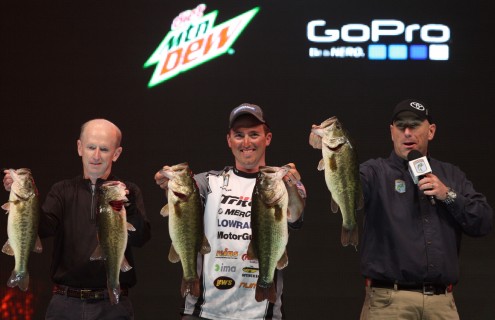 Paul Mueller did a bit of R&D on Lake Guntersville during his record-setting performance at the Bassmaster Classic. Dirty water and aquatic vegetation are the optimum conditions for throwing a ChatterBait. Mueller, who is from Naugatuck, Conn., set a Classic record on Day 2 when he caught a five-bass limit weighing 32 pounds, 3 ounces. He followed it up with 24-11 on Day 3 to finish second in the event, a mere 16 ounces behind champion Randy Howell. And this came after catching only three bass weighing a total of 9-10 on Day 1.
Paul Mueller did a bit of R&D on Lake Guntersville during his record-setting performance at the Bassmaster Classic. Dirty water and aquatic vegetation are the optimum conditions for throwing a ChatterBait. Mueller, who is from Naugatuck, Conn., set a Classic record on Day 2 when he caught a five-bass limit weighing 32 pounds, 3 ounces. He followed it up with 24-11 on Day 3 to finish second in the event, a mere 16 ounces behind champion Randy Howell. And this came after catching only three bass weighing a total of 9-10 on Day 1.
“I don’t throw it a lot,” Mueller said. “Obviously, it’s not one of my strengths or I would have fished it on the first day. It popped in my head as I was rigging up for the second day. When I had 27 pounds at 10:30 (a.m.), I said, ‘I think I’ve got it figured out.'”
Mueller caught all 10 of the bass he weighed the final two days on a Z-Man Original Pro Elite 3/8-ounce, sexy shad-colored ChatterBait. He used a Reins Fat Rockvibe Shad swimbait as a trailer on the lure.
The single 5/0 hook on the ChatterBait made it easier to pull through the aquatic vegetation than the treble-hooked lipless crankbaits that so many anglers were throwing at the Classic. But any kind of lure dragged through the grass at Guntersville was prone to getting caught in it. Rather than ripping the bait out of the vegetation, Mueller realized that a more subtle approach resulted in more strikes.
“I was basically slow rolling it, keeping it as close to the grass as I could without getting hung up,” Mueller said. “But, as the tournament went on, I learned how to fish it more effectively. If I would gently pop it out of the grass, I would get more strikes than if I ripped it out.”
It’s estimated that Brett Hite has won over $400,000 on the FLW tour with bladed jigs as his key lure. Like Mueller did at the Classic, Hite has learned the subtleties of fishing it.
“Once I put a big swimbait on it, it became more of a square-billed swimbait to me,” Hite recently told Rob Newell in an article for the FLW website. “Combining the realistic look of a plastic swimmer with the hardcore deflection of a square-bill (crankbait) has become a deadly combination that really has no limitations regionally or seasonally.”
Ron Davis got an education in another key aspect of the lure business after signing the initial agreement with Z-Man in 2006. He was put in charge of continuing to prosecute the patent applications and also defend the trademark and trade dress rights granted by the U. S. Patent and Trademark Organization.It was a big job.
“There were over 100 entities making some version of the ChatterBait,” Davis said.
Hence the term “bladed jig.” ChatterBait is to bladed jigs what the Alabama Rig is to umbrella rigs and Kleenex is to facial tissue – a trademarked brand.
A couple of victories in court battles helped curtail the number of ChatterBait knock-offs on the market. That was part of the luck factor in the success of ChatterBaits. If Z-Man hadn’t offered all the benefits of a bigger, more established company after the initial success of the ChatterBait, the fishing industry probably would have swallowed RAD Lures like a largemouth bass does a threadfin shad.
“We will be forever grateful to Z-Man,” Ronny said.
Z-Man has since bought all the rights to the ChatterBait from Ronny and Ron Davis.
The father-and-son team isn’t a one-hit wonder. They recently reached an agreement with Strike King to produce and market some new lure designs. One of those – the Strike King Rage Blade – is already available. It’s a further development of the ChatterBait concept with one significant structural difference – rather than the weight of the lure being in the jighead, the weight is on the blade itself. Based on early sales, it appears to be another hit.
“It’s a different lure in function, not just cosmetics,” Ron said.
He predicts more hits to come: “I’m excited about what’s coming down the pike in the next three to five years.”
But nothing will ever match that thrilling first ride up the sales charts. The initial entry of RAD Lures in the fishing industry has created a quite a legacy, one that continues to grow.
“I will always be proud of the ChatterBait,” Ronny Davis said.


